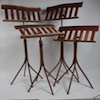Hi all,
I'm making a top to a dresser and the plans call for a 37 degree bevel cut on the underside of the top. I have a jog I built years ago that fits on my fence. My question is how to tilt the blade to that angle since it goes from 45 - 90. I think you take 90 minus 37 which makes it 53. Is this correct? The plans say tilt your blade to 37 degrees.
Let me know if this is a duh moment.




 Reply With Quote
Reply With Quote




